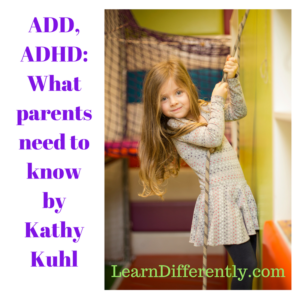What is ADHD? ADD? What parents need to know

By Kathy Kuhl, part 1 of a series Often parents ask me, “I don’t know much about ADD or ADHD. Is there any good material you could send me to educate myself?” Two more parents asked this last week, prodding me to begin this series on attention deficit disorder.
What is Attention Deficit Disorder?
According to help4adhd.org:
Everybody can have difficulty sitting still, paying attention or controlling impulsive behavior once in a while. For some people, however, the problems are so pervasive and persistent that they interfere with every aspect of their life: home, academic, social and work. [Italics added]
As one expert said to an adult patient, “If you only have ADHD at work, you don’t have ADHD.” (Maybe you should look for another job.)

On the other hand, parents sometimes think if a child or teen can focus on something they enjoy, they must not have attention deficit disorder. Parents occasionally tell me, “My child can’t have ADHD. He (or she) can play video games for hours.”
My response:
- Attention Deficit Disorder means having unusual difficulty focusing on something that’s not interesting to the individual. For a typical adult, think of completing tax forms–we may not like it but we can force ourselves. But for others, it’s nearly impossible to tune out the rest of the world or our galloping minds.
- Video games are designed to keep the players engaged every second. The music, sound effects, rhythm, pacing, the visuals–are all meant to draw us in.
ADD, ADHD, AD/HD—what’s the difference?
Attention Deficit Disorder is also called ADD or “Attention Deficit Disorder with or without Hyperactivity Disorder,” abbreviated AD/HD or ADHD. That means you can have ADHD with or without being hyperactive. But some people refer to the non-hyperactive kind as ADD.
Confused? Health care professionals change the name every decade or so, trying to be clearer. Eighty years ago, they called it “Minimal Brain Dysfunction”! For today’s post I’m call them it Attention Deficit or ADHD–meaning with or without the “H.”
Different kinds of Attention Deficit Disorder
Notice those three kinds of behavior mentioned in the quotation above? “Sitting still, paying attention, or controlling impulsive behavior.” Attention problems come in many flavors: distractible, hyperactive, impulsive, inattentive, or some combination. I remember my former students:
–Carla could not, even after seven months in eighth grade, remember to bring a pencil to math class.
–Charlie couldn’t help rocking his desk and chair, and knocking them over in class. One day, when I didn’t see him raising his hand, he stood on a table so his hand would be higher. Only when I told him to get down did he realize he was on the table.
— Brilliant Emily often blurted out things, then pretended she had been making a joke.
What is it like to have attention difficulties? Pat in New York describes her hyperactive daughter:
She can’t help it. She’s just a bundle of movement. It’s not that she’s not paying attention, it’s that everything fascinates her. “Oh, look! Oh, look! Oh, look!” Everything I don’t pay any attention to, she’s absorbed by. It’s not a plot to drive you out of your mind. [Laughs.] It feels that way, but it’s not.
~from my book, Homeschooling Your Struggling Learner, p. 63
On the other hand, my son is not hyperactive, but distractible. He once wrote for me what went throw his mind when I asked him to do the dishes. It filled a page. See pages 5-6 of Homeschooling Your Struggling Learner.
Three kinds of ADHD
To help diagnose ADHD, the American Psychiatric Association publishes a list of symptoms of inattention and a list of symptoms of hyperactivity or impulsivity. If the child (or adult) has enough symptoms for more than six months in at least two different settings (e.g. while homeschooled and at choir practice, or in school and in youth group), a doctor can diagnose the child with ADHD. The symptoms need to be severe enough to interfere with performance.
Those lists lead to three kinds of diagnoses:
- ADHD-primarily inattentive,
- ADHD-hyperactive/impulsive,
- ADHD-combined type, if someone has enough symptoms from both lists.
Teaching kids and teens with Attention Deficit Disorder
Soon I’ll post more about diagnosis, about when it’s not ADHD, and about teaching kids and teens with attention deficit disorder soon. So check back, and sign up at left or below for blog update notices. What would you like me to discuss about attention deficit? Enter your questions in the comments section below. Thank you.
Resources
Handout for my talk, “What Good are Labels? Understanding Your Child’s Learning Challenges”
Understood.org
Help4adhd.org
chrisdendy.com on teens with ADHD.
For a clear but a bit more technical introduction, watch the first twenty minutes of Dr. Vincent Monastra’s ADHD Expert podcast here. (The rest of the talk is on teaching life skills in the classroom.) The ADHD Expert webinars are free and have many interesting speakers. (I have the honor of being one on December 1!) I also recommend ADDitude Magazine, which produces that podcast.


I would love to hear some helpful tools/strategies to help those that struggle with attention.
Thanks!
Thanks, Vanessa, for your comment. Yes, that’s where this series is headed. But I want to lay some groundwork first. Meanwhile, check the “talks” tab above, and look under “handouts” for my handout on “helping distractible students succeed.”
I would like to sign up for notifications that new posts are up. Thank you!
Dara, thanks for this note. We’ve replaced the sign up form and added you to the list. I’ll resume blogging soon.